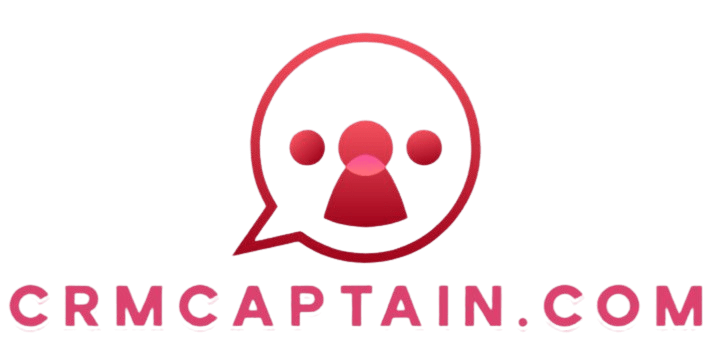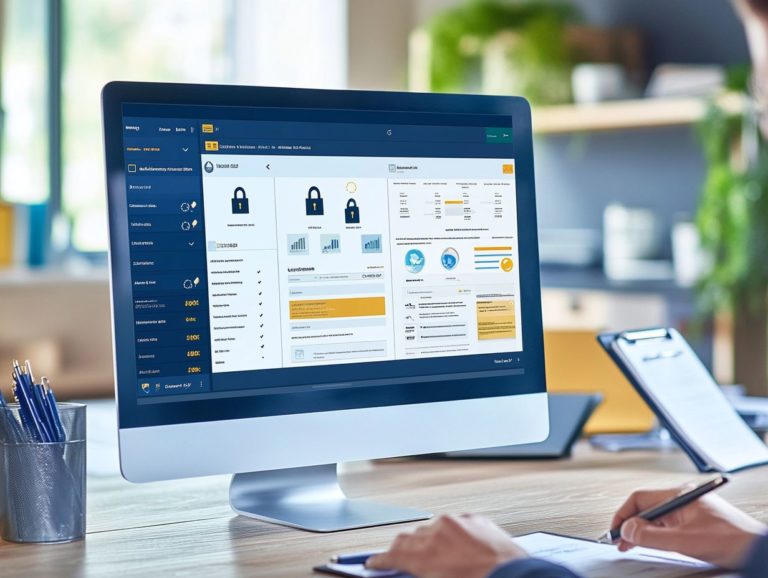What Are CRM Software Best Practices?
In today s fast-paced business landscape, effectively managing customer relationships is essential for your success. CRM (Customer Relationship Management) software stands out as a powerful tool that streamlines your interactions and enhances overall efficiency.
This article delves into the benefits of CRM software, highlighting how it can improve your customer relationships and boost operational effectiveness. You’ll find essential practices for successful implementation, tips on maximizing your CRM s potential, and insights into common pitfalls to avoid.
Dive in to discover how to harness CRM software to elevate your business strategy and drive lasting success.
Contents
- Key Takeaways:
- Benefits of Using CRM Software
- Best Practices for Implementing CRM Software
- Maximizing the Use of CRM Software
- Common Mistakes to Avoid
- Not Customizing for Specific Needs
- Ignoring User Feedback
- Key Takeaways and Final Thoughts
- Frequently Asked Questions
- What Are CRM Software Best Practices?
- Why Are CRM Software Best Practices Important?
- What are some common CRM software best practices?
- How can businesses identify the best CRM software practices for their specific needs?
- Should businesses customize their CRM software best practices?
- What are the consequences of not following CRM software best practices?
Key Takeaways:

Identify your business goals and objectives before implementing CRM software to ensure effectiveness and efficiency.
Invest in proper training and user adoption to maximize the benefits of CRM software and improve customer relationships.
Integrate CRM software with other systems and regularly maintain and update it to optimize its use and avoid common mistakes.
What is CRM Software?
CRM software, or Customer Relationship Management software, is your secret weapon for streamlining and enhancing customer interactions across various touchpoints. By bringing all customer information together and automating essential processes, you can manage your sales pipeline and marketing activities with impressive efficiency.
With advanced features like CRM analytics tools that help analyze customer data for better decision-making lead management, and customer segmentation, you ll unlock valuable insights that foster loyalty and elevate overall customer satisfaction.
A well-implemented CRM system ensures data validation and quality, placing accurate customer information at the heart of your business strategies. These systems often have intuitive, user-friendly interfaces that make navigation a breeze and allow for quick data entry.
This means you and your team can concentrate on building relationships instead of getting tangled in administrative tasks. Automation is key here. It significantly enhances customer service by efficiently handling repetitive tasks like sending follow-up emails or scheduling appointments.
This not only streamlines your processes but also improves response times. Take, for example, platforms like Salesforce and HubSpot. They don t just facilitate communication with your customers; they also provide analytics and reporting tools that let you track performance metrics, ultimately enabling you to make better decisions and achieve higher ROI.
With such robust functionalities, CRM software is undeniably an essential asset for anyone looking to improve customer relationships and operational efficiency in today s competitive landscape.
Benefits of Using CRM Software
The benefits of utilizing CRM software are truly extensive, reshaping your sales process and elevating customer interactions through strategic data management and automation.
When you leverage CRM systems, you can expect to see a significant boost in productivity, enhanced efficiency in your marketing efforts, and improved collaboration among your team members.
With effective CRM software at your disposal, you can meticulously track customer feedback, monitor performance metrics, and refine customer segmentation. This creates a personalized customer journey that boosts satisfaction.
Efficiency and Effectiveness
One of the most significant advantages of implementing CRM software is the remarkable boost in efficiency and effectiveness it brings to your business processes. By automating repetitive tasks like data entry and lead management, you can streamline your sales process and allocate resources more strategically.
This leads to productivity increases across departments, enabling better performance monitoring and allowing you to focus on strategic marketing activities that align with your sales metrics.
When you integrate data from legacy systems into a unified platform, your sales teams gain seamless access to critical customer insights, driving well-considered choices.
With effective CRM analytics tools at your disposal, you can track key performance indicators, uncovering invaluable insights that highlight trends and areas ripe for improvement.
For instance, companies that embrace CRM software often report up to a 30% increase in conversion rates. This is largely due to automated follow-ups and personalized messaging that ensure no lead slips through the cracks.
Such enhancements in sales metrics not only nurture healthier client relationships but also cultivate long-term loyalty.
Improved Customer Relationships
Enhanced customer relationships stand out as a primary advantage of adopting CRM software, allowing you to nurture and sustain meaningful interactions. By creating detailed profiles, you can offer personalized communication and customized marketing efforts.
This elevated engagement fosters customer loyalty, as you can effectively respond to feedback and address their needs, paving the way for enduring relationships.
The significance of customer feedback is paramount; it serves as a compass, guiding you toward refining your strategies and elevating overall satisfaction. An effective CRM system carefully tracks every stage of the customer experience, enabling you to anticipate needs and preferences at each touchpoint.
By analyzing feedback and interaction patterns, you can pinpoint pain points and successes alike, leading to more well-considered choices. This proactive approach enhances your service delivery and strengthens bonds with your customers, encouraging repeat business and generating positive referrals.
Best Practices for Implementing CRM Software

Successfully implementing CRM software demands a comprehensive approach that aligns with your organizational goals. Start by defining clear objectives for a smooth CRM adoption!
Creating an implementation plan that incorporates data validation and customization tailored to your specific needs is vital.
Consultants can provide valuable insights that streamline the process, while robust employee training programs enhance user acceptance and help your teams harness the software s full potential.
Identifying Business Goals and Objectives
Identifying clear business goals and objectives is the cornerstone of a successful CRM implementation, laying a solid foundation for aligning the software’s capabilities with your needs. By understanding your specific objectives, you can tailor your implementation plan to enhance performance metrics and improve data quality.
This helps make sure that the CRM system effectively supports your lead management, customer segmentation, and team collaboration efforts.
Setting measurable targets, such as increasing customer retention rates or improving response times, enables you to gauge progress and refine your strategies along the way. These goals will significantly influence the selection of features and functionalities that best address your current operational challenges.
For instance, if you’re focused on enhancing customer engagement, you might prioritize robust analytics or automated communication tools.
Keeping your data accurate and current is crucial; it ensures well-considered decisions and helps achieve your desired outcomes. Ultimately, this commitment to data integrity makes your CRM initiative much more impactful.
Training and User Adoption
Effective employee training and user adoption strategies are essential to maximize the value derived from your CRM software. A comprehensive training program equips your team with the skills needed to navigate the system and fosters acceptance by showcasing the software’s user-friendly features.
Continuous support and performance monitoring after the training phase keep your teams engaged and enable them to leverage the CRM to its full potential.
Implementing hands-on workshops encourages active participation and real-world application for an enhanced training experience.
User manuals will serve as valuable reference points, allowing your staff to revisit key functionalities whenever necessary. Ongoing support through dedicated help desks or online forums efficiently addresses any emerging questions or challenges.
By emphasizing user adoption, you promote effective integration and help achieve your set goals. Regular feedback sessions and performance metrics that highlight progress will ultimately ensure the long-term success of your CRM initiative.
Ready to enhance your customer relationships? Let s get started with CRM today!
Maximizing the Use of CRM Software
Maximizing your CRM software’s potential requires a strategic integration with other systems, along with a steadfast commitment to regular maintenance and updates.
By ensuring seamless data integration between your CRM and legacy systems, you can significantly enhance data accuracy and streamline operations.
Consistent updates and diligent data validation processes will bolster the reliability of your customer data, enabling your teams to make informed decisions that elevate customer interactions and drive growth.
Integrating with Other Systems
Integrating CRM software with your business systems is crucial for creating a smooth flow of information and maximizing smooth operations.
When you implement effective data integration, you can harness the full potential of your customer data. This means automating processes, boosting cooperative efforts across departments, and eliminating isolated data that cannot be easily accessed or shared.
You ll gain more flexibility and accessibility by leveraging cloud CRM solutions, ensuring you have real-time insights to support your decision-making.
By connecting your CRM systems with marketing automation tools, sales platforms, and customer support channels, you create a unified approach to managing customer relationships. This connection not only streamlines your communication but also cultivates a more personalized experience for your customers.
Consider companies like HubSpot and Salesforce; they ve shown how integrating CRM with email marketing and analytics can lead to impressive increases in lead conversion rates. Firms that incorporate customer service tools into their CRM often report shorter response times and improved customer satisfaction ratings, clearly showcasing the tangible benefits of these integrations.
Regular Maintenance and Updates

Regular maintenance and updates are essential for keeping your CRM software effective and aligned with your ever-evolving business needs.
By adopting a structured approach to maintenance, you can proactively identify and address potential issues related to data validation and system performance.
Periodic updates not only enhance the software’s capabilities but also help maintain user engagement and satisfaction, fostering a culture of continuous improvement.
Establishing a maintenance schedule allows for timely troubleshooting and adjustments, ultimately leading to better overall system performance.
You’ll benefit significantly from consistently monitoring performance metrics and soliciting user feedback to pinpoint areas that need attention.
By analyzing this data, you can make informed decisions about necessary enhancements or feature expansions, ensuring that the software evolves alongside user expectations.
This strategy can truly give you an edge over competitors! It not only helps you maintain a competitive edge but also strengthens user loyalty by demonstrating your commitment to optimizing their experience with the CRM platform.
Common Mistakes to Avoid
Avoiding common mistakes during CRM implementation is essential for fully harnessing the benefits of customer relationship management systems.
Organizations often falter by overlooking the critical need for customization to meet specific requirements, neglecting to involve end-users in the process, and dismissing data quality concerns.
These oversights can impede user acceptance and diminish overall effectiveness, ultimately resulting in less-than-ideal outcomes in both sales processes and customer interactions.
Take action today to avoid these pitfalls and ensure a successful CRM implementation!
Not Customizing for Specific Needs
One common mistake organizations make when implementing CRM software is neglecting to customize the system to fit their specific needs. A one-size-fits-all approach can lead to inefficiencies and user frustration.
It s crucial to tailor the CRM solution with user-friendly features. Consider input from employees during the customization process.
This not only promotes user buy-in but also boosts overall productivity. Customization ensures that the CRM integrates seamlessly into existing workflows.
For instance, your sales team could benefit from dashboards highlighting relevant metrics. Meanwhile, your marketing department may need specific tracking for campaign performance.
Involving stakeholders from various departments during customization allows you to gather valuable insights. This leads to more relevant features and promotes engagement.
When users see the system is tailored for them, they’ll embrace it. This maximizes the CRM s potential to drive your organization s success.
Ignoring User Feedback
Ignoring user feedback can undermine the effectiveness of your CRM implementation. Regularly asking for input helps identify areas for improvement.
Prioritizing user feedback enhances customer interactions and boosts satisfaction with your CRM solution. Actively seeking input cultivates a culture of openness and collaboration.
One effective strategy is to use anonymous surveys, allowing team members to share thoughts without hesitation. Implement regular check-in meetings to encourage ongoing discussions about user experiences.
This proactive engagement creates a sense of ownership among users. Encouraging them to fully embrace the CRM system leads to continuous refinement and innovation.
As you refine your approach based on feedback, you unlock greater efficiencies. This ensures your CRM aligns with user needs and business goals.
Key Takeaways and Final Thoughts
Implementing CRM software requires a carefully designed plan that prioritizes user buy-in and customization. Investing in employee training and actively seeking user feedback enhances your ability to build strong customer relationships.
Your organization must provide ongoing support after implementation. This ensures users feel confident in utilizing the system fully.
This commitment not only elevates the user experience but also improves customer satisfaction and loyalty. As you leverage CRM tools effectively, expect substantial long-term benefits.
Benefits include streamlined processes, enhanced data management, and the ability to anticipate customer needs. Ultimately, this approach paves the way for organizational success and strengthens your market position.
Frequently Asked Questions

What Are CRM Software Best Practices?
CRM (Customer Relationship Management) software best practices are effective ways to use CRM software to manage customer relationships. Understanding what features CRM software should have can help tailor these practices to a business’s specific needs and goals.
Why Are CRM Software Best Practices Important?
CRM software best practices help businesses maximize the benefits of their CRM system. Following these practices improves customer relationships, increases sales, and streamlines processes.
What are some common CRM software best practices?
Regularly updating customer data is crucial. Set clear goals for using the system and train employees on effective software use.
Integrating Customer Relationship Management (CRM) with other business systems allows for a smooth flow of information.
How can businesses identify the best CRM software practices for their specific needs?
To find the best CRM practices, assess your business goals first. Consider current processes and spots where CRM can boost efficiency.
Researching and consulting with CRM experts can provide tailored guidance.
Should businesses customize their CRM software best practices?
Absolutely! Tailoring CRM practices to fit unique business needs is essential. While general best practices exist, customization helps maximize system effectiveness.
What are the consequences of not following CRM software best practices?
Not following best practices may cause serious setbacks! You risk inaccurate customer data, inefficient processes, and missed sales opportunities.
These issues hinder your ability to manage and enhance customer relationships.






